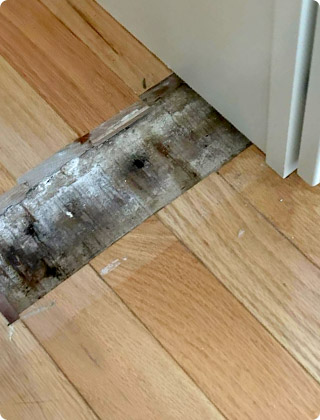
Different Types of Mold on Wood: How to Identify and Remove Them
Wood is one of the most common building materials in homes, furniture, and commercial spaces. Unfortunately, it's also highly susceptible to mold growth. Moisture, humidity, and poor ventilation can all lead to mold thriving on wooden surfaces. If left untreated, mold can damage structures, ruin furniture, and negatively impact indoor air quality.
Knowing how to recognize the types of mold on wood helps protect both property and health. From black mold on wood to orange mold, each type looks different and comes with its own risks. This article explains what mold looks like on wood, how to identify it, the dangers of certain species, and safe ways to get rid of it.
What Causes Mold to Grow on Wood?
Wood is both porous and organic, making it an ideal environment for mold spores to thrive. Mold requires moisture, warmth, and a food source, and wood provides all three. When water or humidity penetrates the surface, mold can start growing rapidly, sometimes within 24 to 48 hours. Understanding the common causes of mold growth is essential for prevention and early detection.
Roof or Plumbing Leaks That Soak into Wood
Leaks from roofs, pipes, or plumbing fixtures can saturate wooden beams, floors, or furniture. Even small, slow leaks can provide enough moisture for mold to develop over time, often in hidden areas that are difficult to detect without professional testing.
High Humidity in Crawl Spaces, Attics, or Basements
Poorly ventilated spaces like crawl spaces, attics, and basements often experience high humidity. Regular mold testing can identify growth before it spreads.
Poor Ventilation, Especially in Bathrooms or Kitchens
Bathrooms, kitchens, and laundry areas often generate heat and moisture. Without proper exhaust fans or ventilation, humidity levels rise, increasing the likelihood of mold forming on wood surfaces such as cabinets, flooring, or paneling.
Flooding or Water Damage That Wasn't Properly Dried
Flooding or leaks from storms and plumbing failures leave wood saturated. If it's not dried thoroughly, mold can appear within days. In these cases, professional mold testing services are recommended for safety and proper cleanup.
Mold growth doesn't just damage wood - it can lower indoor air quality, triggering allergies, coughing, and other health issues. For homes or commercial properties, timely mold detection helps maintain a safe environment while preventing structural damage and costly repairs.
What Does Mold Look Like on Wood?
Not every stain or dark spot is mold. Some marks may be from water stains, soot, or the wood's natural grain. However, mold often shows distinct characteristics:
- Texture: Fuzzy, powdery, or slimy depending on type and moisture.
- Color: Common hues include black, green, white, and orange.
- Spread: Irregular, patchy growth expanding over time.
- Smell: A musty odor often reveals hidden colonies.
Combining these clues helps distinguish real mold from surface marks. Proper identification guides safe removal and protects indoor environments.
Types of Mold on Wood and Their Risks
Black Mold on Wood
Appearance: Dark green to nearly black patches, sometimes slimy in high humidity.
Risks: Some strains like Stachybotrys chartarum can produce toxins linked to headaches, coughing, and breathing irritation. Not all black mold is toxic, but even non-toxic types can weaken wood and impact air quality.
Common areas: Basements, crawl spaces, and around leaks.
Orange Mold on Wood
Appearance: Orange mold often appears slimy or powdery and may form in clustered patches. It's usually easy to spot against natural wood tones.
Risks: Dangerous orange mold on wood is less common than black mold, but it can still cause allergic reactions, skin irritation, or breathing difficulties.
Common areas: Because it thrives in damp, moisture-rich environments, it's commonly found in bathrooms, kitchens, and areas where condensation lingers.
White Mold on Wood
Appearance: White mold often looks like a powdery or fuzzy coating, which can easily be mistaken for dust or mineral deposits such as efflorescence.
Risks: While less toxic, white mold can cause damage to wooden structures by breaking down fibers.
Common areas: It spreads quickly and may reduce the structural integrity of flooring, beams, or furniture.
Green Mold on Wood
Appearance: Bluish-green and fuzzy. It often grows alongside black mold in areas of long-term moisture.
Risks: Though less dangerous than toxic black mold, green mold may still trigger health problems such as sneezing, watery eyes, or asthma flare-ups.
Common areas: It is especially common in attics, basements, and any poorly ventilated space.
How to Identify Mold on Wood?
If you're unsure whether you're looking at mold or just staining, here are key steps:
- Visual Check - Look for irregular fuzzy or slimy growth.
- Touch Test - Mold often wipes off or smears, unlike stains. (Use gloves.)
- Smell Test - Musty odors are a red flag.
- Moisture Check - Use a moisture meter to confirm dampness in wood.
- Professional Help - For certainty, hire mold air sampling services or an indoor air quality company.
While DIY inspection works for small cases, professional mold testing provides a clear diagnosis. This is especially important if you suspect toxic species or need documentation for insurance or real estate purposes.
How to Get Rid of Mold on Wood Safely?
DIY Methods
If you're dealing with small, non-toxic mold growth, these safe home remedies can help:
- Vinegar - Spray undiluted vinegar directly on the affected wood, let it sit for at least an hour, then scrub gently. It kills many types of mold on wood and prevents regrowth.
- Hydrogen Peroxide - A 3% solution works well for porous surfaces. Apply, let it bubble, and wipe clean to disinfect and remove stains.
- Baking Soda - Mix with water to create a paste or spray. It's a natural cleaner that deodorizes wood and helps prevent mold from returning.
- Light Sanding - For surface-level mold only. Always wear protective gear (mask, gloves) to avoid inhaling spores.
- Dehumidifiers - Use in damp areas like basements or crawl spaces to reduce moisture and stop mold from coming back.
Professional Methods
For larger infestations or potentially toxic mold, hiring experts is the safest approach:
- Mold Inspection Services - Certified professionals perform thorough visual inspections and use moisture meters to identify hidden growth in walls, floors, or crawl spaces.
- Mold Testing Services - Air sampling and surface tests determine the type and severity of mold, ensuring accurate treatment plans.
- Professional Remediation - Technicians use specialized antifungal treatments, HEPA vacuums, and containment methods to remove mold safely without spreading spores.
- Structural Repairs - Experts address water damage or leaks, preventing future mold growth on wood.
- Indoor Air Quality Monitoring Services - Continuous monitoring helps ensure that indoor air remains safe after remediation.
Professional mold testing and removal not only eliminate current infestations but also reduce health risks and prevent costly structural damage, making it a smart investment for both homeowners and businesses.
Preventing Mold from Returning
Killing mold is only the first step, prevention is essential to keep your wood surfaces and indoor air safe. Here are key strategies:
- Fix Leaks Immediately - Whether from roofs, plumbing, or condensation, repairing leaks prevents moisture accumulation that encourages mold growth.
- Use Exhaust Fans - Install and run exhaust fans in bathrooms, kitchens, and laundry areas to reduce humidity levels.
- Improve Ventilation - Ensure proper airflow in attics, crawl spaces, and basements. Consider vents, fans, or dehumidifiers to keep these areas dry.
- Maintain Indoor Humidity Below 50% - Mold thrives in humid conditions, so controlling moisture is critical for long-term prevention.
- Schedule Routine Mold Testing - Regular residential or commercial testing helps detect problems early, before they spread.
- Consider Indoor Air Quality - Continuous monitoring keeps you protected and alerts you to moisture or mold risks.
Conclusion
Mold on wood is common but manageable with prompt attention. Whether you're facing black mold on wood or lighter surface growth, no mold should be ignored. Early identification and safe removal protect both structure and health.
However, DIY solutions aren't always enough. For large or recurring mold issues, professional testing and inspection services are the safest options. Experts not only remove existing mold but also help prevent it from coming back.
Contact O2 Mold Testing certified specialists today for professional mold inspection and testing services. Call today at 888-202-1680 for a consultation you can trust.
FAQ
Is mold on wood furniture dangerous?
Not all mold on wood furniture is toxic, but some types, like black mold, can trigger allergic reactions, coughing, and respiratory issues.
How to clean mold off wood?
To safely remove mold from wood, wear protective gear, clean small areas with vinegar or baking soda, dry thoroughly, and call professional mold remediation for larger infestations.
How to prevent mold growth on wood?
Preventing mold starts with controlling moisture. Fix leaks immediately, keep indoor humidity below 50%, and ensure proper ventilation in crawl spaces, attics, and basements.


